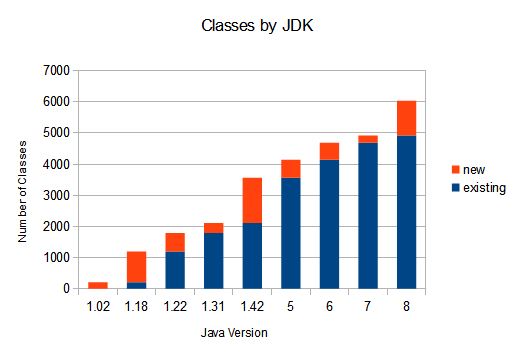 Java (SE) 8 was released on the 18th of March 2014. Unlike previous releases it did not have a code name like Tiger or Dolphin. Spider was proposed as unofficial name on Code Ranch because of "8 legs, and a strong association with webs." It was an exciting release with huge changes, with probably similar or even larger impact than Java 5, which brought Generics. The new features (and the ones that did not make it into Java 8 yet) show that Java is on its way to be a modern and productive programming language.
Java (SE) 8 was released on the 18th of March 2014. Unlike previous releases it did not have a code name like Tiger or Dolphin. Spider was proposed as unofficial name on Code Ranch because of "8 legs, and a strong association with webs." It was an exciting release with huge changes, with probably similar or even larger impact than Java 5, which brought Generics. The new features (and the ones that did not make it into Java 8 yet) show that Java is on its way to be a modern and productive programming language.Numbers
The
rt.jar and other JARs located in the lib folder of the JRE contain many classes. For each new release I take a look at the new (public) classes. The list of new classes complements the list of new language features. Java 8 adds more than 1000 public classes, mainly in the packages javafx.*. Without JavaFX there are 251 added classes, similar to Java 7.
Lambdas and Streams
The major library changes are to support Lambda Expressions and the related Stream API. The new
java.util.function package contains all types of possible function types.java.lang.FunctionalInterface
java.lang.invoke.LambdaConversionException
java.lang.invoke.LambdaMetafactory
java.lang.invoke.MethodHandleInfo
java.lang.invoke.SerializedLambda
java.util.function.
BiFunction Function Predicate
ToDoubleBiFunction DoubleFunction BiPredicate
ToIntBiFunction IntFunction DoublePredicate
ToLongBiFunction LongFunction IntPredicate
LongPredicate
BinaryOperator DoubleToIntFunction
DoubleBinaryOperator DoubleToLongFunction Supplier
IntBinaryOperator IntToDoubleFunction BooleanSupplier
LongBinaryOperator IntToLongFunction DoubleSupplier
LongToDoubleFunction IntSupplier
Consumer LongToIntFunction LongSupplier
BiConsumer ToDoubleFunction
DoubleConsumer ToIntFunction UnaryOperator
IntConsumer ToLongFunction DoubleUnaryOperator
LongConsumer IntUnaryOperator
ObjDoubleConsumer LongUnaryOperator
ObjIntConsumer
ObjLongConsumerThe Streams are in the package java.util.stream,Stream Stream$Builder StreamSupport BaseStream DoubleStream DoubleStream$Builder IntStream IntStream$Builder LongStream LongStream$Builder Collector Collector$Characteristics Collectorsas well as some additions to
java.util for splitting and collecting.java.util.DoubleSummaryStatistics java.util.IntSummaryStatistics java.util.LongSummaryStatistics java.util.Spliterator java.util.Spliterator$OfDouble java.util.Spliterator$OfInt java.util.Spliterator$OfLong java.util.Spliterator$OfPrimitive java.util.Spliterators java.util.Spliterators$AbstractDoubleSpliterator java.util.Spliterators$AbstractIntSpliterator java.util.Spliterators$AbstractLongSpliterator java.util.Spliterators$AbstractSpliterator java.util.SplittableRandom java.util.StringJoinerJava 8 Date and Time API
The next big change is the new date and time API. It contains a lot of new classes to model and use dates and time in your code.
java.time.Clock ...format.DateTimeFormatter
java.time.DateTimeException ...format.DateTimeFormatterBuilder
java.time.DayOfWeek ...format.DateTimeParseException
java.time.Duration ...format.DecimalStyle
java.time.Instant ...format.FormatStyle
java.time.LocalDate ...format.ResolverStyle
java.time.LocalDateTime ...format.SignStyle
java.time.LocalTime ...format.TextStyle
java.time.Month
java.time.MonthDay ...temporal.ChronoField
java.time.OffsetDateTime ...temporal.ChronoUnit
java.time.OffsetTime ...temporal.IsoFields
java.time.Period ...temporal.JulianFields
java.time.Year ...temporal.Temporal
java.time.YearMonth ...temporal.TemporalAccessor
java.time.ZonedDateTime ...temporal.TemporalAdjuster
java.time.ZoneId ...temporal.TemporalAdjusters
java.time.ZoneOffset ...temporal.TemporalAmount
...temporal.TemporalField
...chrono.AbstractChronology ...temporal.TemporalQueries
...chrono.ChronoLocalDate ...temporal.TemporalQuery
...chrono.ChronoLocalDateTime ...temporal.TemporalUnit
...chrono.Chronology ...temporal.UnsupportedTemporalTypeException
...chrono.ChronoPeriod ...temporal.ValueRange
...chrono.ChronoZonedDateTime ...temporal.WeekFields
...chrono.Era
...chrono.HijrahChronology ...zone.ZoneOffsetTransition
...chrono.HijrahDate ...zone.ZoneOffsetTransitionRule
...chrono.HijrahEra ...zone.ZoneOffsetTransitionRule$TimeDefinition
...chrono.IsoChronology ...zone.ZoneRules
...chrono.IsoEra ...zone.ZoneRulesException
...chrono.JapaneseChronology ...zone.ZoneRulesProvider
...chrono.JapaneseDate
...chrono.JapaneseEra
...chrono.MinguoChronology
...chrono.MinguoDate
...chrono.MinguoEra
...chrono.ThaiBuddhistChronology
...chrono.ThaiBuddhistDate
...chrono.ThaiBuddhistEraAnd Other ClassesThere are several new classes all over the place. The most notable are:
- Reflection for Type Annotations.
- Finally a Base 64 encoder and decoder.
Optional.CompletableFutureandStampedLock.
java.lang.annotation.Native java.io.UncheckedIOException
java.lang.annotation.Repeatable
java.net.URLPermission
java.lang.reflect.AnnotatedArrayType
java.lang.reflect.AnnotatedParameterizedType java.sql.DriverAction
java.lang.reflect.AnnotatedType java.sql.JDBCType
java.lang.reflect.AnnotatedTypeVariable java.sql.SQLType
java.lang.reflect.AnnotatedWildcardType
java.lang.reflect.Executable java.util.Base64
java.lang.reflect.MalformedParametersException java.util.Base64$Decoder
java.lang.reflect.Parameter java.util.Base64$Encoder
java.security.DomainLoadStoreParameter java.util.Calendar$Builder
java.security.KeyStore$Entry$Attribute java.util.Locale$FilteringMode
java.security.PKCS12Attribute java.util.Locale$LanguageRange
java.security.spec.DSAGenParameterSpec
java.util.Optional
java.security.cert.CertPathChecker java.util.OptionalDouble
java.security.cert.PKIXRevocationChecker java.util.OptionalInt
java.security.cert.PKIXRevocationChecker$Option java.util.OptionalLong
java.util.spi.CalendarDataProvider java.util.PrimitiveIterator
java.util.spi.CalendarNameProvider java.util.PrimitiveIterator$OfDouble
java.util.spi.ResourceBundleControlProvider java.util.PrimitiveIterator$OfInt
java.util.PrimitiveIterator$OfLong
java.util.concurrent.atomic.DoubleAccumulator
java.util.concurrent.atomic.DoubleAdder
java.util.concurrent.atomic.LongAccumulator
java.util.concurrent.atomic.LongAdder
java.util.concurrent.CompletableFuture
java.util.concurrent.CompletableFuture$AsynchronousCompletionTask
java.util.concurrent.CompletionException
java.util.concurrent.CompletionStage
java.util.concurrent.ConcurrentHashMap$KeySetView
java.util.concurrent.CountedCompleter
java.util.concurrent.locks.StampedLockAdditional changes cover additions to UI capabilities - JavaFX is now part of the JRE. The Java Language Model has been updated (javax.lang.model) and Rhino has been replaced by Nashorn (package jdk.nashorn). There are more changes, e.g. stronger security algorithms, but these do not show up as new classes.Summary
Java 8 brings big changes for the language, finally adding closures to Java. This is as ground breaking as Java 5's Generics. Lambdas and Streams will change the way we write Java and allow a more functional style in our code.
You can download the complete list of all classes available in Java 8. Each class name is annotated with [release] showing the release it first appeared, e.g.
java.lang.annotation.Annotation [5]. Package access classes are marked by a lowercase p, e.g. java.lang.CharacterName [7p].














